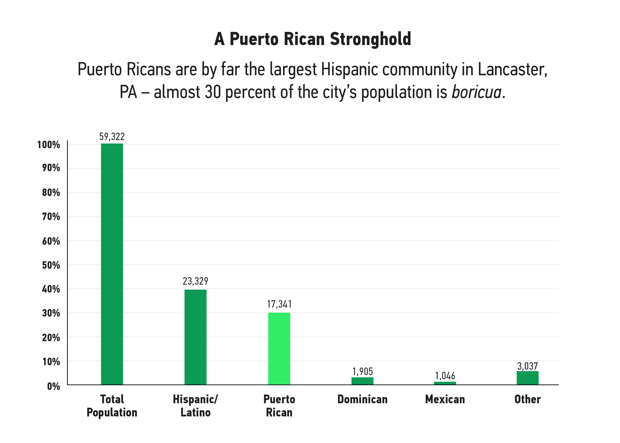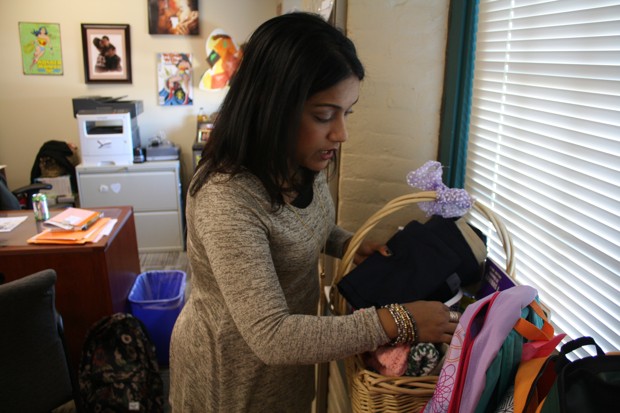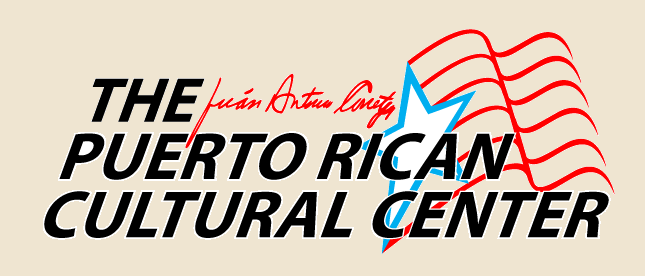MARTÍN ECHENIQUE FEB 28, 2018
ORIGINAL ARTICLE HERE – CityLab.Com
Lancaster, Pennsylvania, is taking in hundreds of evacuees from Puerto Rico. For many, the transition has been a challenge.
LANCASTER, Pennsylvania—When Hurricane Maria came for Carlos Rodríguez, he locked himself, his wife, and his two children in a small bathroom in his house in Gobernador Piñero, southwest of San Juan, Puerto Rico. The wind whistled through the cracks of the door and threatened to blast through the window; on the other side of his street, the roof of his neighbors’ home was torn off.
“Maria has been the strongest storm I’ve ever experienced,” says Rodríguez. “It just wiped out everything.”
“We are starting from scratch,” Rodriguez told his wife.
The Lancaster connection
Lancaster, Pennsylvania is a small city of 60,000 in southeastern Pennsylvania. It may not seem like the first place that comes to mind when considering where Puerto Ricans might resettle. But Lancaster has been welcoming immigrants for centuries: Most famously, the Amish community that lives in the nearby farms of Lancaster County began settling here in the 1720s, after escaping religious persecution in Europe.
Most Maria refugees have migrated to Florida: An estimated 200,000 former residents of the island chose to move to the metropolitan areas of Miami and Orlando. Many others have gone to New York City and New Jersey. But Pennsylvania, which has the fourth-largest population of Puerto Ricans living in the continental U.S., has also received thousands of families. They’ve come not only to Philadelphia, where 8 percent of the city’s population is Puerto Rican, according to the 2010 Census, but to smaller towns—Lebanon, Allentown, Reading, and Lancaster. Almost 30 percent of Lancaster’s residents are Puerto Rican or boricua (Americans of Puerto Rican descent), according to data from the 2016 American Community Survey.

Lancaster’s new mayor, Danene Sorace, wasn’t surprised to learn that evacuees were heading to town. “I knew immediately that we were going to be welcoming family members into the city, for sure,” says Sorace.
“It’s been crazy,” says Yirmares Cuevas, director of Lancaster’s Spanish American Civic Association, which has been helping to support the new arrivals. “I’ve never seen anything like this before in my 16 years at SACA.”
Puerto Ricans have been in Lancaster for decades: During the 1960s, the first wave of transplants began to arrive in this part of Pennsylvania, driven by rising housing costs in New York and New Jersey and the promise of industrial jobs. As the Puerto Rican debt crisis deepened in recent years, that migration accelerated. Today, almost 40 percent of the city’s population is Hispanic, and most are Puerto Rican, a proportion second only to Reading.
The region has several attractions for newcomers. Lancaster is one of a relatively modest number of small Rust Belt cities to enjoy economic growth in recent years, thanks in part to its healthy tourist sector and proximity to Philadelphia and Baltimore. Cafes, restaurants, art galleries, and vinyl record stores abound along Prince Street, one of the historic main drags in the city. Hidden inside a building in the center of the city, across the street from the country’s oldest farmer’s market, is Old San Juan, a new Puerto Rican restaurant. It’s one of a handful of visible signs of the thriving boricua community hidden away here.

The shape of the Maria migration is driven largely by personal networks, perceived job opportunities, and especially family ties. Lancaster’s existing Puerto Rican community has been a key draw, says Edwin Meléndez, director of the Center for Puerto Rican Studies at the City University of New York (CUNY). “Friends, relatives, or acquaintances are those who transmit the information to those who want to leave the island,” he says. “Many times [relatives] are the ones in charge of receiving newcomers and help them in those first weeks in the new place.”
“We didn’t have any plans”
Rodríguez and his family landed at Baltimore/Washington International Airport on the chilly evening of Thanksgiving Day. The plan was to rent a car, but with his limited English skills he got on the wrong shuttle and wasn’t able to get to the rent-a-car facilities located away from the terminal. He had to find a way to get his family to Lancaster, more than 80 miles away. His son called and suggested Uber.
Many of the Maria refugees who relocated to the Northeast U.S. this winter found themselves similarly poorly prepared, starting with the weather. (On Christmas Day in San Juan, it was 80 degrees; Lancaster’s temperatures hovered just above freezing.) With limited resources, the islanders not only arrived without adequate clothing, but they found it difficult to access assistance in obtaining housing, jobs, food aid, and English classes.
While Orlando and New York have established relief centers, created websites available in Spanish, made communication efforts on social media, and established hotlines to engage with the evacuees, smaller locations have struggled to provide services aimed at refugees, many of whom arrived with little more than the clothes they were wearing. Lancaster, for example, now has a website, but it’s only in English and doesn’t link the evacuees with local social organizations that provide direct assistance; there’s no office, telephone number, or email specifically for newly arrived Puerto Ricans.

The municipal government of Lancaster, as in most smaller U.S. cities, doesn’t really have the capacity to directly provide residents with social services related to education, housing, or work. “The city’s never had that capacity because of the structure that local government has here,” says Sorace. “Our lane is kind of narrow. But what we can do is make sure that the connections are being made to the organization who can.”
So, how does a small city deal with hundreds of people who arrive (legally) after having been displaced by a natural disaster, like any other U.S. citizen would? One answer lies in social organizations like SACA, which has so far assisted 95 Puerto Rican families in navigating the city.
For many of these newcomers, the biggest challenge is housing. The average monthly rent for a home in Lancaster exceeds $1,100, and many landlords ask for up to two months of deposit and credit reports—daunting barriers for families that have literally lost everything. The waiting list for federal housing assistance is no longer counted in months, but in years, according to Gray.

The lack of coordination between local, state, and federal governments—plus the various nonprofits involved—isn’t helping, either. According to SACA’s Cuevas, local nonprofits, the school district, and agencies like FEMA sent people from one place to another, and evacuees had problems understanding the role of the mayor and the local government; it was SACA, she says, that had to start functioning as the main point of entry to support incoming Puerto Rican families since January 22, along with churches and social organizations.
The uphill road
It’s been more than two months since Carlos Rodríguez and his family arrived in Lancaster. His children, who are 11 and 7 years old, are now going to school and learning English. His wife works an early shift in a soda factory; her days begin at 4 am.
Their combined income from Carlos’ job at church isn’t enough for them to move out of Carlos’ son’s house, he says. “Right now, to get a house, they ask for a credit check. A person like me, who after the storm was left without a job, paid his mortgage a little behind, and comes here [to Lancaster], and they ask you for that—how do they do that? Don’t they have a heart?”
His problems are common among other recent arrivals from Puerto Rico, as he has seen. Earlier that day, he says, he met a woman who was desperate to get a job, but she did not know where to look for one, or how to move around the city. Lancaster has a limited bus system with only a few routes in the city. “The bus does not work well,” says Rodriguez, who was used to driving everywhere he needed to go on the island. Now, he spends his days walking. When he had to get from his son’s house to the post office recently, it took him two hours to walk there, each way.
“It’s not just walking into the door and needing food stamps, filling an application, getting them and done, you’re happy,” says Cuevas. “It’s the language barrier, [the fact that] your degree that is not valid in Pennsylvania, the housing, the job thing, the weather. It’s ‘What do I do?’ It’s starting your whole life again. It’s thinking what you left behind.”
For Rodriguez, the church has been his foundation, his place of peace, and, for now, a source of faith that things will improve.
“I thought it would be a little easier, but everything has gone uphill,” says Rodriguez. With his eyes fixed on the ground, he makes an effort not to cry. “If you do not have faith, you honestly go crazy here, because you do not have a job, because you can not find a home, because you do not have enough money. And in the end, you have no choice. Returning to Puerto Rico is not even an option. I don’t even have a place to return to.”
This story originally appeared in Spanish on our sister site CityLab Latino.






